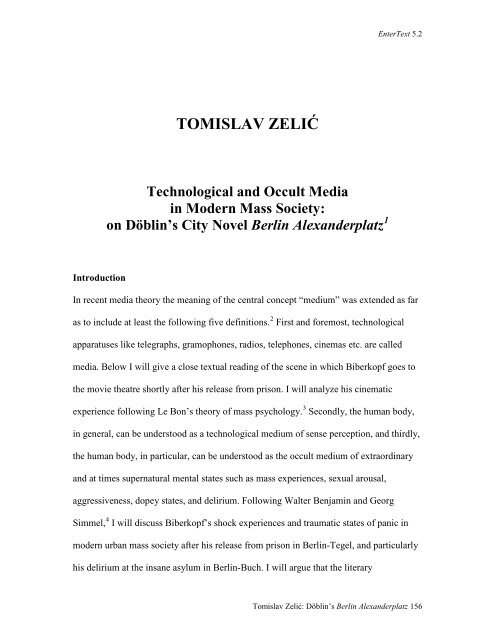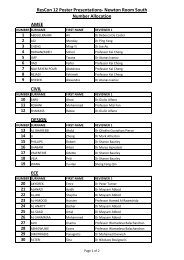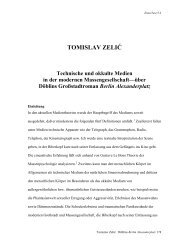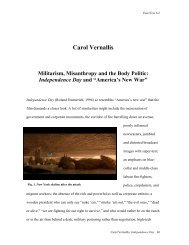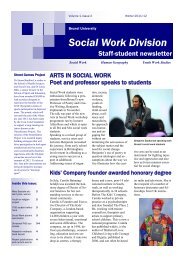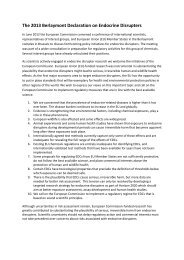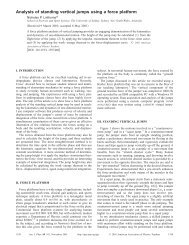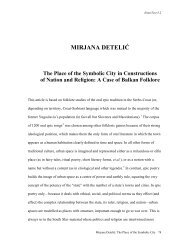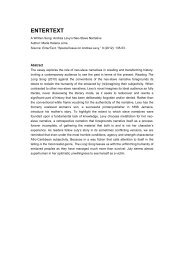Tomislav Zelic: Technological and Occult Media ... - Brunel University
Tomislav Zelic: Technological and Occult Media ... - Brunel University
Tomislav Zelic: Technological and Occult Media ... - Brunel University
You also want an ePaper? Increase the reach of your titles
YUMPU automatically turns print PDFs into web optimized ePapers that Google loves.
Introduction<br />
TOMISLAV ZELIĆ<br />
<strong>Technological</strong> <strong>and</strong> <strong>Occult</strong> <strong>Media</strong><br />
in Modern Mass Society:<br />
on Döblin’s City Novel Berlin Alex<strong>and</strong>erplatz 1<br />
EnterText 5.2<br />
In recent media theory the meaning of the central concept “medium” was extended as far<br />
as to include at least the following five definitions. 2 First <strong>and</strong> foremost, technological<br />
apparatuses like telegraphs, gramophones, radios, telephones, cinemas etc. are called<br />
media. Below I will give a close textual reading of the scene in which Biberkopf goes to<br />
the movie theatre shortly after his release from prison. I will analyze his cinematic<br />
experience following Le Bon’s theory of mass psychology. 3 Secondly, the human body,<br />
in general, can be understood as a technological medium of sense perception, <strong>and</strong> thirdly,<br />
the human body, in particular, can be understood as the occult medium of extraordinary<br />
<strong>and</strong> at times supernatural mental states such as mass experiences, sexual arousal,<br />
aggressiveness, dopey states, <strong>and</strong> delirium. Following Walter Benjamin <strong>and</strong> Georg<br />
Simmel, 4 I will discuss Biberkopf’s shock experiences <strong>and</strong> traumatic states of panic in<br />
modern urban mass society after his release from prison in Berlin-Tegel, <strong>and</strong> particularly<br />
his delirium at the insane asylum in Berlin-Buch. I will argue that the literary<br />
<strong>Tomislav</strong> Zelić: Döblin’s Berlin Alex<strong>and</strong>erplatz 156
EnterText 5.2<br />
representation of these experiences does not only fulfil Döblin’s self-proclaimed poetic<br />
program of a “cinematic style” (Kinostil) 5 in the Berliner Programm of 1913, but also<br />
that the novel internally reflects on the status <strong>and</strong> the function of technological <strong>and</strong> occult<br />
media, both visually <strong>and</strong> acoustically. Fourthly, following recent systems theoretical<br />
approaches to modern literature, the general theoretical distinction between medium <strong>and</strong><br />
form, 6 I will argue that modern mass society serves as the medium for Döblin’s novelistic<br />
form <strong>and</strong> that the average person Biberkopf, whose individual criminal, juridical, <strong>and</strong><br />
psychiatric case history is stored at least fictitiously in the social network of discourses<br />
<strong>and</strong> disciplines, serves as the exemplary form of the individual in modern mass society.<br />
Last but not least, from an external perspective, the novel itself can be seen as a medium<br />
<strong>and</strong> as a medium in competition with emerging new media. In this context, I will discuss<br />
the contemporary cultural debate about the crisis of the novel. 7<br />
The <strong>Technological</strong> Medium Cinema <strong>and</strong> the <strong>Occult</strong> Medium…<br />
…or Biberkopf goes to the movies<br />
Biberkopf has just been released from prison in Berlin-Tegel, after having served a four<br />
year sentence for having murdered his girl-friend in affect. He has just gone through a<br />
series of shock experiences in the now unfamiliar urban environment of modern mass<br />
society. He has just suffered through traumatic states of panic in the dark backyard where<br />
the two Jews picked him up <strong>and</strong> brought him to their apartment. On his flight from urban<br />
modernity, Biberkopf returns to closed spaces reminiscent of the prison cell he just left:<br />
the dark urban backyards <strong>and</strong> apartments of Berlin, but also <strong>and</strong> not so incidentally the<br />
dark interior of a movie theatre. After pushing through the crowd in the rain, Biberkopf<br />
catches attention of a movie poster announcing a popular pornographic comedy of the<br />
time:<br />
<strong>Tomislav</strong> Zelić: Döblin’s Berlin Alex<strong>and</strong>erplatz 157
Children under seventeen not allowed. On the huge poster a<br />
beet-red gentleman was st<strong>and</strong>ing on a staircase, while a<br />
peach of a young girl embraced his legs, she lay on the<br />
stairs, <strong>and</strong> he stood up above with a leering expression on<br />
his face. Underneath was written: Parentless, Fate of an<br />
Orphaned Child, in Six Reels. 8<br />
EnterText 5.2<br />
The following description of the location <strong>and</strong> the plot summary would certainly reinforce<br />
the bigot suspicions against <strong>and</strong> the moralistic rejection of the new medium cinema<br />
voiced by contemporary conservative cultural critics.<br />
The long room was packed full, 90 percent men with work-caps<br />
on, they don’t take them off. The three lamps on the ceiling are<br />
covered with red. In front, a yellow piano with packages on top of<br />
it. The orchestrion makes a continuous racket. Then it gets dark<br />
<strong>and</strong> the film starts. A goose-girl is to be given culture, just why, is<br />
not made so clear, at least not right in the middle. She wiped her<br />
nose with her h<strong>and</strong>, she scratched her behind on the staircase,<br />
everybody in the movie laughed. Franz thought it was quite<br />
wonderful, when the tittering started up around him. Just folks,<br />
free folks, amusing themselves, nobody has the right to say<br />
anything to them, simply lovely, <strong>and</strong> I right here among ‘em! It<br />
went on. The high-toned Baron had a sweetheart who lay in a<br />
hammock <strong>and</strong> stretched her legs vertically in the air. The girl had<br />
drawers on. That’s something. Wonder why people get so excited<br />
about that dirty goose-girl <strong>and</strong> her licking the platters clean?<br />
Again the girl with the slim legs flashed by. The Baron had left her<br />
alone, now she toppled out of the hammock, <strong>and</strong> flopped onto the<br />
grass, lay there stretched out. Franz stared at the screen, there was<br />
already another picture, he still saw her toppling out laying there<br />
stretched out. He gnawed his tongue, hell’s bell, what was that?<br />
But when finally the one who had been the goose-girl’s lover<br />
embraced his fine lady, the skin of his chest felt hot as if he had<br />
been embracing her himself. It went all over him <strong>and</strong> made him<br />
weak. 9<br />
In his Study of the Popular Mind entitled The Crowd of 1895 Gustave Le Bon, a<br />
conservative cultural critic, specifies the alterations in the psychic constitution of the<br />
individual who is undergoing mass experience. 10 Although for the most part, Le Bon had<br />
the crowd of the French Revolution in mind when he designed his theory, there seems to<br />
<strong>Tomislav</strong> Zelić: Döblin’s Berlin Alex<strong>and</strong>erplatz 158
EnterText 5.2<br />
be a structural analogy between his mass psychological analysis <strong>and</strong> the functioning of<br />
the emerging new medium cinema, which coincidentally was invented by the Lumière<br />
brothers in the very same year, 1895, that Le Bon’s study was published. In other words,<br />
cinema may be seen as the absent point of reference to early mass psychological theory.<br />
Therefore, the cinematic experience lends itself to be interpreted in terms of the socio-<br />
psychological analysis of mass experience, <strong>and</strong> the individual who is a member of the<br />
crowd, in fact, shares some of the psychosomatic features with the individual who is a<br />
member of the movie audience.<br />
Most importantly, in his cinematic experience Biberkopf resembles occult human<br />
media who are hypnotized under the spell of a hypnotist who in this case is replaced by<br />
the technological apparatus of cinematography. Like a hypnotized medium, Biberkopf<br />
loses parts of his conscious personality, <strong>and</strong> his intellectual abilities are weakened, while<br />
his emotional excitability is intensified. He thinks associatively in the illogical rhythms of<br />
cinematic images. 11 Le Bon uses several medical, physiological, psychological, <strong>and</strong><br />
occult concepts to describe the state of fascination, attentiveness, <strong>and</strong> expectation into<br />
which the individual enters when undergoing a mass experience: contagion, paralysis,<br />
suggestion, hypnotism, mesmerism, <strong>and</strong> automatism. In medico-psychological<br />
examinations for legal purposes, Judicial Assessor Dr. Albert Hellwig inquires into “the<br />
suggestive power of the cinematographic presentation” (Suggestivkraft der<br />
kinematographischen Vorführung) 12 <strong>and</strong> claims that the suggestive power could “cause<br />
illusions <strong>and</strong> hallucinations of other sense organs.” 13 In an earlier essay he already<br />
proposed that cinematic images could “leave behind lasting impressions” <strong>and</strong> “inspire<br />
ruinous thoughts”, which in some cases could even lead to the committal of crimes. 14<br />
<strong>Tomislav</strong> Zelić: Döblin’s Berlin Alex<strong>and</strong>erplatz 159
EnterText 5.2<br />
Similarly, Biberkopf is exposed to the suggestive power of the hypnotic medium<br />
cinema. By staring on the movie screen he is caused to take instinctual actions in an<br />
altered state of mind. Although other images are already occurring on the movie screen,<br />
he mentally retains <strong>and</strong> perpetuates the images of the Baron’s lover, a female who is<br />
wearing pants <strong>and</strong> vertically stretching her slim legs up until eventually falling out of the<br />
hammock into the grass. Not unlike the visual process of condensation <strong>and</strong> displacement<br />
(Verschiebung und Verdichtung) that Freud described in reference to dream work<br />
(Traumarbeit), 15 Biberkopf transposes these erotically charged movie images of the<br />
Baron’s lover into mental images of a Weibsstück that he instinctually sets out to find in<br />
the city immediately after leaving the movie theatre. He remains anonymous in the<br />
metropolitan crowd at the movie theatre while being sexually aroused in public by both<br />
the cinematic images on screen <strong>and</strong> his private mental images. However, his rashness,<br />
vehemence, <strong>and</strong> spontaneity finally result in violence, atrocity, <strong>and</strong> ferocity against the<br />
prostitute, <strong>and</strong> his impotence, depression, <strong>and</strong> pursuit of more fundamental physiological<br />
exigencies like food, drink, <strong>and</strong> sleep.<br />
The Human Being as <strong>Technological</strong> Medium of Sense Perception…<br />
…or Biberkopf’s street car ride<br />
From a methodologically anti-humanist perspective, the human body can be seen as both<br />
the technological <strong>and</strong> occult medium of sense perception. As we know from Walter<br />
Benjamin, sense perception as such is not an anthropological constant but historically<br />
conditioned. “During long periods of history, the mode of human sense perception<br />
changes with humanity’s entire mode of existence. The manner in which human sense<br />
perception is organized, the medium in which it is accomplished, is determined not only<br />
<strong>Tomislav</strong> Zelić: Döblin’s Berlin Alex<strong>and</strong>erplatz 160
EnterText 5.2<br />
by nature but by historical circumstances as well.” 16 The meaning of “medium” here is<br />
ambiguous, for it certainly refers both to the human body or psyche <strong>and</strong> its environment.<br />
Hence the historical conditioning of the medium occurs in social <strong>and</strong> psychic terms on<br />
the one h<strong>and</strong>, <strong>and</strong> not only in phylogenetic but also ontogenetic terms, on the other h<strong>and</strong>.<br />
After his release from the prison in Berlin-Tegel, Biberkopf’s first challenge of<br />
re-integrating into society is a simple streetcar ride. Under the title “On Car 41 into<br />
Town” (Mit der 41 in die Stadt), which refers to the downtown-bound streetcar line<br />
number 41 departing from Berlin-Tegel, the intense psychosomatic effects <strong>and</strong> the visual<br />
or cinematic character of the metropolitan shock experience is captured by literary<br />
means.<br />
He shook himself <strong>and</strong> gulped. He stepped on his own feet. Then,<br />
with a run, took a seat in the car. Right among people. Go ahead.<br />
At first it was like being at the dentist’s, when he has grabbed a<br />
root with a pair of forceps, <strong>and</strong> pulls; the pain grows, your head<br />
threatens to burst. He turned his head back towards the red wall,<br />
but the car raced on with him along the tracks, <strong>and</strong> only his head<br />
was left in the direction of the prison. The car took a bend; trees<br />
<strong>and</strong> houses intervened. Busy streets emerged, Seestrasse, people<br />
got on <strong>and</strong> off, it’s going to start now. The tip of his nose turned to<br />
ice; something was whirring over his cheek. 17<br />
Witness the double movement of the streetcar <strong>and</strong> Biberkopf’s head focusing on its<br />
object of sense perception as if Biberkopf took the position of the camera on top of the<br />
streetcar that is driving through the metropolis in Vertov’s avant-garde experimental<br />
documentary film Man with a Camera (1929). 18 The fragmentation of the visual field<br />
induced by objects of sense perception covering up each other prefigures the traumatic<br />
states of panic, the vertigo, <strong>and</strong> the hallucinations in later passages. Amongst all of these,<br />
the fear of the roofs sliding from the buildings is used like a leitmotiv throughout the<br />
novel. The first time it is represented it is related to a sense perception coded in cinematic<br />
<strong>Tomislav</strong> Zelić: Döblin’s Berlin Alex<strong>and</strong>erplatz 161
EnterText 5.2<br />
terms. After disembarking from the streetcar Biberkopf is running through the city on<br />
Rosenthaler Straße.<br />
The cars roared <strong>and</strong> jangled on, house-fronts were rolling<br />
along one after the other without stopping. And there were<br />
roofs on the houses, they soared atop the houses, his eyes<br />
w<strong>and</strong>ered straight upward: if only the roofs don’t slide off,<br />
but the houses stood upright. 19<br />
With respect to Biberkopf’s situation, it is clear that the mental <strong>and</strong> bodily<br />
deprivations in prison resulted in the atrophying of the “defensive organ”<br />
(Schutzorgan), 20 which makes the city-dweller indifferent to the shock experiences of the<br />
constant flux of discrepant stimuli from the urban environment. The development of “the<br />
protection against stimuli” (Reizschutz) 21 normally constitutes the rationalistic <strong>and</strong> blasé<br />
character typical for city-dwellers who respond to stimuli intellectually rather than<br />
emotionally. 22 In contrast, Biberkopf suffers psychosomatically from traumatic states of<br />
panic <strong>and</strong> sudden sexual or aggressive outburst, since he is deprived of most of his<br />
“defensive organ” <strong>and</strong> unable to rationalize the metropolitan shock experiences. As a<br />
helpless object, he is unable to distance himself rationally from the psychosomatic<br />
impacts of metropolitan dynamic automatisms on his body. His subjectivity is submerged<br />
in the functional discourse <strong>and</strong> discipline networks almost throughout – with some<br />
exceptional passages written in the style closer to the realist psychological novel. Thus<br />
Biberkopf’s individuality constitutes a mere “intersection of social circles” (Kreuzung<br />
sozialer Kreise), to use Simmel’s definition of individuality in modern mass society. 23<br />
<strong>Tomislav</strong> Zelić: Döblin’s Berlin Alex<strong>and</strong>erplatz 162
The Delirious Body as <strong>Occult</strong> Medium…<br />
…or Biberkopf’s Symbolical Death <strong>and</strong> Rebirth<br />
EnterText 5.2<br />
In connection with his visit to the cinema, we found that Biberkopf can be seen as an<br />
occult hypnotized medium or non-autonomous subject while the movie projector, a<br />
technological medium, functions like a hypnotist. Throughout, Döblin’s novel establishes<br />
an interrelation between the technological medium cinema <strong>and</strong> the occult medium or<br />
hypnotized subject which suffers from extraordinary mental states like sexual or<br />
aggressive impulses, traumatic states of panic, <strong>and</strong> deliria. Repressed aggressive impulses<br />
issued by the id <strong>and</strong> military orders to keep one’s head issued from the superego surface<br />
in the universal metropolitan mass discourse as “free indirect discourse” (erlebte Rede). 24<br />
In the polyperspectival city novel, they cannot be assigned easily to the perspective of<br />
any particular character or one of the many narrator’s voices. After the fare dodger<br />
Biberkopf escapes from the police, having taken a free ride on the streetcar, he submerges<br />
in the metropolitan crowd <strong>and</strong> makes an uncanny experience by looking at a shop<br />
window when he realizes that the metropolitan crowd, “it”, or in German es, is exhausted<br />
in its functionality <strong>and</strong> represented in “the petrified style” (steinerner Stil). 25<br />
Zwölf Uhr Mittagszeitung, B.Z., Berliner Illustrierte, Die<br />
Funkstunde. “Anybody else got on?” The coppers have blue<br />
uniforms now. He got off the car, without being noticed, <strong>and</strong> was<br />
back among people again. What happened? Nothing. Chest out,<br />
you starved sucker, you, pull yourself together, or I’ll give you a<br />
crack in the jaw! Crowds, what a swarm of people! How they<br />
hustle <strong>and</strong> bustle! My brain needs oiling, it’s probably dried up.<br />
What was all this? Shoe stores, hat stores, inc<strong>and</strong>escent lamps,<br />
saloons. People got to have shoes to run around so much; didn’t we<br />
have a cobbler’s shop out there, let’s bear that in mind! Hundreds<br />
of polished window-panes, let ‘em blaze away, are they going to<br />
make you afraid or something, why, you can smash ‘em up, can’t<br />
you, what’s the matter with ‘em, they’re polished clean, that’s all.<br />
<strong>Tomislav</strong> Zelić: Döblin’s Berlin Alex<strong>and</strong>erplatz 163
The pavement on Rosenthaler Platz was being torn up; he walked<br />
on the wooden planks along with the others. Just go ahead <strong>and</strong> mix<br />
in with the people, then everything’s going to clear up, <strong>and</strong> you<br />
won’t notice anything, you fool. Wax figures stood in the showwindows,<br />
in suits, overcoats, with skirts, with shoes <strong>and</strong> stockings.<br />
Outside everything was moving, but—back of it—there was<br />
nothing! It—did not—live! It had happy faces, it laughed, waited<br />
in twos <strong>and</strong> threes on the newspapers. This it stood there like the<br />
street-lamps—<strong>and</strong>—became more <strong>and</strong> more rigid. They belonged<br />
with the houses, everything white, everything wooden. 26<br />
The interrelation between the technological medium cinema <strong>and</strong> the occult<br />
EnterText 5.2<br />
medium or hypnotized subject becomes clearer when the phenomenon is unambiguously<br />
represented from the character’s perspective <strong>and</strong> coded in occult terms from the<br />
narrator’s perspective as in Biberkopf’s psychosomatic reaction to an altercation with<br />
some workers who had just sung the International. At the beginning of the episode,<br />
Biberkopf is in the position of the hypnotized moviegoer whose body is fixed to the seat<br />
but paradoxically in “numbness” (Starre) <strong>and</strong> in great psychosomatic distress or “frenzy”<br />
(Tobsucht) at the same time. After depersonalization sets in—Biberkopf hears his roaring<br />
<strong>and</strong> sees himself from the distance as a doppelganger—<strong>and</strong> the leitmotiv fear re-emerges,<br />
the episode culminates in a clairvoyant fantasy of naked violence.<br />
A frenzy, a numbness comes over Franz Biberkopf. Blindly he<br />
croaks in his throat, his eyes are glassy, his face blue, bloated, he<br />
spits, his h<strong>and</strong>s burn, the man’s out of his mind. His fingers claw<br />
the chair, but he manages to hold on to it. Soon he will take the<br />
chair <strong>and</strong> haul out.<br />
Danger ahead, clear the streets, load, fire, fire, fire.<br />
At the same time this roaring man hears his own voice, from far<br />
away, is looking at himself. The houses, the houses threaten to<br />
cave in again, the roofs to smash over him, this won’t do, no, they<br />
can’t get away with that, those criminals won’t succeed, what we<br />
need is order.<br />
Something buzzes inside him: it’s going to start soon <strong>and</strong><br />
I’m going to do something, grab a throat, no, no, I’m about to<br />
topple over, fall down, another moment, just another moment<br />
more. And me thinking the world is quiet, there is law <strong>and</strong> order.<br />
In his twilight state he is frightened: something is out of gear with<br />
<strong>Tomislav</strong> Zelić: Döblin’s Berlin Alex<strong>and</strong>erplatz 164
the world, the others seem so terrible to him, he experiences it with<br />
a sort of clairvoyance. 27<br />
EnterText 5.2<br />
Like resurfacing repressed aggressive impulses, repressed homosexual impulses <strong>and</strong><br />
political resentment surface in a homophobic <strong>and</strong> anticommunist paranoiac discourse<br />
coded in terms of cinematic <strong>and</strong> occult media effects: “What do these people want<br />
anyway, first the fairies who don’t concern me, <strong>and</strong> now the Reds? (…) Something<br />
flares <strong>and</strong> flickers in Franz’s eyes, his forehead <strong>and</strong> nose become thick.” 28 And yet at<br />
other times the combination of homosexuality <strong>and</strong> communist political attitudes in certain<br />
characters have occult, hypnotic, magnetic, or mesmerizing effects on Biberkopf which<br />
will finally prove to be fatal. “Franz feels powerfully attracted to him (Reinhold).” 29<br />
More importantly, Biberkopf’s delirium or, as the narrator, it seems, would have<br />
it, symbolic death <strong>and</strong> rebirth at the insane asylum in Berlin-Buch is not only represented<br />
in terms of the Expressionist conception of the new human being based on the religious<br />
idea of re-embodiment or the Christian concept of the resurrection of the flesh but again<br />
also in psychiatric terms of acoustic <strong>and</strong> visual hallucinations, in mass psychological <strong>and</strong><br />
occult terms of suggestibility <strong>and</strong> hypnotism, <strong>and</strong> finally in technological terms of<br />
cinematic effects. After having made a stance against the police during shootings <strong>and</strong> a<br />
consequent police round-up <strong>and</strong> at the Alex<strong>and</strong>erquelle, the authorities institutionalize<br />
Biberkopf at the insane asylum in Berlin-Buch where he enters into a state which the<br />
doctors <strong>and</strong> psychiatrist there quickly diagnose as “catatonic stupor.” 30 Biberkopf’s<br />
delirious body is a mere chassis (Gehäuse) 31 which is soulless, out of service, <strong>and</strong><br />
disengaged from external social interpersonal communicative reality while producing an<br />
excessive flux of internal mental images.<br />
<strong>Tomislav</strong> Zelić: Döblin’s Berlin Alex<strong>and</strong>erplatz 165
At first Biberkopf receives an imaginary visitor, the allegorical figure of the<br />
harvester death who is the main member in the famous medieval dance of death,<br />
however, ironically speaking fluently in Berlin dialect. The subsequent “profane<br />
enlightenment,” 32 in fact, features stroboscopic light effects reminiscent of side <strong>and</strong><br />
special effects of cinematographic representation. “And a luminous hatchet flashes<br />
EnterText 5.2<br />
through the air, it flashes <strong>and</strong> is extinguished.” 33 The cinematic flux of stroboscopic light<br />
is paralleled with the allegorical dismemberment of the delirious human body featured as<br />
a gradually accelerated repetitive mechanistic process reciting earlier slaughterhouse<br />
scenes. “Swing up, fall down, hack in, swing up, crash down, hack in, swing, fall, hack,<br />
swing fall hack, swing hack, swing hack.” 34 Biberkopf undergoes the “radical cure”<br />
(Gewaltkur) through which, at least according to the narrator’s comment in the preface,<br />
he will be “bent straight again” (zurechtgebogen) before returning to Alex<strong>and</strong>erplatz<br />
looking “greatly changed <strong>and</strong> battered” (verändert, ramponiert). 35 The literary<br />
representation of <strong>and</strong> self-reflection on the status of the human being as technological <strong>and</strong><br />
occult medium of extraordinary mental states such as delirious hallucinations mimetically<br />
constructs cinematic visual <strong>and</strong> poetic acoustic effects.<br />
Excursus: Poetics of Psychiatric Knowledge<br />
In a study about Döblin’s Poetics of Psychiatric Knowledge, as the subtitle announces,<br />
Wolfgang Schäffner 36 argues that Döblin’s professional experiences as an institutional<br />
doctor <strong>and</strong> office-based neurologist granted him access to the fields of knowledge such as<br />
the clinic, the insane asylum, <strong>and</strong> the prison, all of which in turn served as the material<br />
<strong>Tomislav</strong> Zelić: Döblin’s Berlin Alex<strong>and</strong>erplatz 166
for the novel. 37 In the Berliner Programm Döblin rejects all psychologizing <strong>and</strong><br />
EnterText 5.2<br />
historicizing modes of literary representation <strong>and</strong> proposes “to learn from psychiatry.”<br />
We should learn from psychiatry, the only science that<br />
deals with the human soul as a whole: it recognized the<br />
naivety of psychology a long time ago; it limits itself to the<br />
notation of processes <strong>and</strong> movements—shaking its head<br />
<strong>and</strong> shrugging its shoulder at everything else, the question<br />
as to why <strong>and</strong> how. (…) It points us to a way out of<br />
psychological prose. (…) The subject of the novel is<br />
soulless reality. (…) In the face of the abundant materials<br />
the representation requires a cinematic style. 38<br />
In other words, Döblin’s program calls for ignoring character’s inner mental states in the<br />
classical style of the realistic psychological novel of the nineteenth century <strong>and</strong> instead<br />
recommends focusing on purely materialistic data from a mechanistic functionalistic<br />
point of view on the human being. And insofar as prognostic empirical sciences like<br />
criminal studies, demography, <strong>and</strong> statistics serve as the fundament of modern psychiatry,<br />
which is based on statistical probability <strong>and</strong> causality, 39 the modern novel uses media of<br />
mass culture <strong>and</strong> everyday materials such as phone books <strong>and</strong> meteorological reports.<br />
Under these theoretical presupposition, Schäffner exposes the division of labour<br />
between psychiatry, law, <strong>and</strong> literature in support of the claim that although legal<br />
psychiatry was conceived in order to humanize the criminal law, it actually contributed to<br />
the aggravation <strong>and</strong> expansion of juridical techniques of disciplining <strong>and</strong> observing both<br />
criminals <strong>and</strong> the mentally ill. Secondly, Schäffner claims that a new type of insane<br />
asylum emerged out of this alliance between doctors <strong>and</strong> lawyers <strong>and</strong> that Berlin-Buch<br />
ranks amongst the first institutions of this kind, where according to Döblin’s psychiatric<br />
reform program disturbed patients are to be healed, languishing paralyzed patients are to<br />
be accommodated, <strong>and</strong> degenerate patients are to be detained. 40<br />
<strong>Tomislav</strong> Zelić: Döblin’s Berlin Alex<strong>and</strong>erplatz 167
EnterText 5.2<br />
Schäffner goes on to characterize the therapeutic optimism of the judicial system<br />
<strong>and</strong> psychiatry inherent in their hopes of achieving the goal of normalization by means of<br />
therapeutic disciplining. Precisely to this end, Biberkopf, whom the judicial <strong>and</strong> medical<br />
authorities deem to be a confirmed jailbird if not mentally ill alcoholic, is<br />
institutionalized in Berlin-Buch. There his hallucinatory states of panic are methodically<br />
intensified beyond any measure <strong>and</strong> the orthopaedic torture therapy <strong>and</strong> disciplining of<br />
the body follows the guidelines of a bio-political program according to which life must be<br />
preserved <strong>and</strong> penitentiary processes pursue improvement rather than punishment. Thus a<br />
contemporary legal expert could claim that the transformation of Biberkopf, the<br />
transportation worker who murdered his fiancée in affect, to Biberkopf, a functional,<br />
equally respected as respectable member of society, is the showpiece of winning back a<br />
criminal for the human society. 41 Döblin’s novel, therefore, becomes the model of the<br />
successful improvement of a criminal personality <strong>and</strong> the confirmation for the therapeutic<br />
optimism shared by lawyers <strong>and</strong> psychiatrists alike. 42<br />
In the final analysis, at least Döblin’s narrator in Berlin Alex<strong>and</strong>erplatz seems to<br />
suggest that the psychiatric cure was accomplished, for Biberkopf, in fact, ends up<br />
working as an assistant doorman in a medium-sized factory, that is to say, in a fixed <strong>and</strong><br />
static position, <strong>and</strong> most probably medico-therapeutically immobilized by psychotropic<br />
agents, while around him everybody moves about dynamically <strong>and</strong> transiently, be it the<br />
personnel in the factory, be it the National-Socialists <strong>and</strong> Communists marching the<br />
streets of Berlin in 1929 competing for political power with each other. In contrast to<br />
both contemporary Marxist <strong>and</strong> present-day post-Marxist critics, who either bemoan that<br />
at the end of the novel the profanely enlightened gangster was elevated into the heavens<br />
<strong>Tomislav</strong> Zelić: Döblin’s Berlin Alex<strong>and</strong>erplatz 168
EnterText 5.2<br />
of novelistic characters by becoming a sage, 43 or who respectively see the ideal-typical<br />
German Michel, that is, the selfless, de-politicized, conformist petite bourgeois in<br />
Biberkopf, 44 the end result actually seems to be the best possible result beyond the<br />
classical idealistic program of the Bildungsroman that nonetheless remains the negative<br />
backdrop against which these critics judge Biberkopf’s story. 45 After all, in reference to<br />
both the Communists <strong>and</strong> the National Socialists, Biberkopf or the narrator rhymes<br />
ironically: “Reason is the gift of man, jackasses replace it with a clan.” 46<br />
The Metropolitan Masses <strong>and</strong> the Exemplary Average Person as the Medium <strong>and</strong><br />
Form of Modern Society<br />
In reference to Robert Musil’s novel Man Without Qualities, Benno Wagner applies the<br />
systems theoretical distinction between medium/form to claim that, sociologically<br />
speaking, the human beings en mass are the medium of modern society, <strong>and</strong> that,<br />
culturally speaking, human beings en mass are the medium of modern city literature. 47<br />
The systems theoretical distinction between medium/form extends the concept of the<br />
medium as far that, as a contemporary German media theorist ironically noted, “nothing<br />
is not a medium.” 48 Now Wagner emphasizes the lose coupling of the medium, that is the<br />
human beings en mass, <strong>and</strong> the stable coupling of the form, that is society or the novel,<br />
on the one h<strong>and</strong>, <strong>and</strong> the homogeneity <strong>and</strong> substitutability of the elements of the medium,<br />
on the other h<strong>and</strong>. Since Döblin’s novel has a title, Berlin Alex<strong>and</strong>erplatz, <strong>and</strong> a subtitle,<br />
The Story of Franz Biberkopf, which, as a side note, Döblin’s editor persisted in adding to<br />
the title, I would like to add that while its medium certainly is the lose coupling of<br />
individuals in modern mass society, the fictitious character Biberkopf as an exemplary<br />
average person (Durchschnittsmensch) is its form on the one h<strong>and</strong>. But on the other h<strong>and</strong>,<br />
the narrator sees Biberkopf as an occult medium of dark forces. 49<br />
<strong>Tomislav</strong> Zelić: Döblin’s Berlin Alex<strong>and</strong>erplatz 169
From a systems theoretical st<strong>and</strong>point, the social <strong>and</strong> the psychic system are<br />
EnterText 5.2<br />
environments to each other <strong>and</strong> yet there is “interpenetration” 50 between them, while<br />
from a psychoanalytic st<strong>and</strong>point the average person st<strong>and</strong>s in a double conflict against<br />
both external nature <strong>and</strong> culture on the one h<strong>and</strong>, <strong>and</strong> by virtue of sublimated<br />
renouncement of sexual <strong>and</strong> aggressive drives for civilizing purposes against repressed<br />
inner nature <strong>and</strong> culture on the other h<strong>and</strong>. 51 To put it following Simmel’s terminology<br />
once again, Biberkopf is an “intersection of social circles,” 52 precisely to the extent that<br />
he resides in the interspaces between the metropolitan discourse <strong>and</strong> discipline networks<br />
which are ordered according to binary codes. Thus he is neither homosexual nor<br />
heterosexual, 53 he neither loves Mieze/Sonja nor Reinhold, in terms of the discourse of<br />
gender <strong>and</strong> sexuality, he is neither Nazi nor Communist in terms of the historico-political<br />
discourse, neither employed nor unemployed in terms of the economical discourse,<br />
neither respectable [anständig] nor criminal in terms of the legal discourse, 54 <strong>and</strong> one<br />
may add neither normal nor pathological in terms of the psychiatric discourse.<br />
The City Novel as the Medium <strong>and</strong> the Form of Modern Mass Society<br />
In face of the competition between old <strong>and</strong> new media (Medienkonkurrenz) “The Day of<br />
the Book” (Tag des Buches) was officially instituted in the Weimar Republic in 1929. 55<br />
Unsurprisingly enough until today in the public discourse around the book fairs<br />
(Buchmessen), cultural conservative <strong>and</strong> pessimistic voices are heard bemoaning the<br />
asymmetry between the production <strong>and</strong> consumption of books <strong>and</strong> the overall damaging<br />
effects of the new media’s superpower in modern mass society. In response to the<br />
predominantly economical crisis of the book as perceived by the publishing industry in<br />
<strong>Tomislav</strong> Zelić: Döblin’s Berlin Alex<strong>and</strong>erplatz 170
EnterText 5.2<br />
general, <strong>and</strong> the cultural crisis of the novel in particular, 56 Döblin increases self-reference<br />
in both his programmatic <strong>and</strong> poetic writings. 57 The preface of the novel begins with<br />
“This book […]” („Dies Buch…”) 58 <strong>and</strong> gives a self-commentating summary of the<br />
story, exposing its banality by using war, boxing, <strong>and</strong> chess metaphors. In a later passage<br />
where the harvester death visits Biberkopf <strong>and</strong> sings the songs of death, the narrator<br />
ironically reflects on the novel as media as well as on songs, poetry, <strong>and</strong> music as other<br />
media.<br />
That certainly is a beautiful song. Franz hears it <strong>and</strong><br />
wonders what it means: Death is singing? If it were printed<br />
in a book, or read aloud, it would be rather like poetry,<br />
Schubert composed such songs, Death <strong>and</strong> the Maiden, but<br />
what about it? 59<br />
Subsequently, the harvester death tells Biberkopf ironically reflecting on his own status<br />
as technological medium:<br />
I called you again <strong>and</strong> again, <strong>and</strong> you take me for a mere<br />
record player, for a gramophone to turn on, whenever you<br />
please, then I have to call you, <strong>and</strong> when you have enough,<br />
you simply stop the record. That’s what you take me for, or<br />
that’s whatcha take me for. Go ahead <strong>and</strong> take me for it, but<br />
I tell you you’re wrong. 60<br />
To note on the margins, amongst other means of increasing self-reference in the novel are<br />
the use of rhetorical figures such as alliteration, assonance, rhythmic as well as melodic<br />
verses, <strong>and</strong> rhymes, all of which are sound effects highlighting the materiality <strong>and</strong><br />
mediality of language, 61 <strong>and</strong> the intertextual parodying <strong>and</strong> derisive use of ancient Greek<br />
mythology (Orestes), the Bible (Apocalypse, Book of Hiob), <strong>and</strong> the allegorical figures<br />
(the whore Babylon, the harvester Death). Again wireless communication of the Erinnyes<br />
<strong>Tomislav</strong> Zelić: Döblin’s Berlin Alex<strong>and</strong>erplatz 171
from the ancient Greek myth of the Oresteia is contrasted with the means of<br />
communication in the modern technological age.<br />
EnterText 5.2<br />
More importantly, however, the realistic external-referential (fremdreferentiell)<br />
observation of the functioning of the metropolitan discourse <strong>and</strong> discipline networks from<br />
a cold analytical point of view is enriched with equally realistic self-referential<br />
reflections, e.g., the narrator’s commentary with overtones of a pitiless <strong>and</strong> ironical<br />
ballad-monger not unlike in Brecht’s epic theatre, almost essayistic but instantaneous<br />
reflections about programmatic <strong>and</strong> poetic questions as to the status of the novel as a<br />
medium, the literary representability of the metropolitan crowd <strong>and</strong> the city itself, the<br />
usefulness of literature in general.<br />
There are men, women, <strong>and</strong> children, the latter mostly<br />
holding women’s h<strong>and</strong>s. To enumerate them all <strong>and</strong> to<br />
describe their destinies is hardly possible, <strong>and</strong> only in a few<br />
cases would this succeed. The wind scatters chaff over all<br />
of them alike. The faces of the eastward w<strong>and</strong>erers are in<br />
no way different from those of the w<strong>and</strong>erers to the west,<br />
south <strong>and</strong> north; moreover they exchange theirs roles, those<br />
who are now crossing square towards Aschinger’s may be<br />
seen an hour later in front of the empty Hahn Department<br />
Store. Just as those who come from Brunnenstrasse on their<br />
way to Jannowitz Brücke mingle with those coming from<br />
the reverse direction. Yes, <strong>and</strong> many of them turn off to the<br />
side, from south to east, from south to west, form north to<br />
west, from north to east. They have the same equanimity as<br />
passengers in an omnibus or in street-cars. The latter all sit<br />
in different postures, making the weight of the car, as<br />
indicated outside, heavier still. Who could find out what is<br />
happening inside them, a tremendous chapter. And if<br />
anyone did write it, to whose advantage would it be? New<br />
books? Even the old ones don’t sell, <strong>and</strong> in the year ’27<br />
book-sales as compared with ’26 have declined so <strong>and</strong> so<br />
much per cent. 62<br />
In this passage, the question as to the literary representability of the metropolitan crowd<br />
<strong>and</strong> the city itself is raised <strong>and</strong> answered by mimicking film scripts <strong>and</strong> citing cinematic<br />
<strong>Tomislav</strong> Zelić: Döblin’s Berlin Alex<strong>and</strong>erplatz 172
EnterText 5.2<br />
modes of representation, e.g., the high-angle shots of the metropolitan crowd as they are<br />
used in Walter Ruttmann’s Sinfonie einer Großstadt (1929). The novel also reflects on its<br />
own status as a medium with reference to the annual book market quotas, on the one<br />
h<strong>and</strong>, <strong>and</strong> on its own status as literature, on the other h<strong>and</strong>, with reference to <strong>and</strong><br />
programmatic rejection of the outdated writing style of the realistic psychological novel<br />
of the nineteenth century which by the late twenties has been in crisis for quite some<br />
time. “Who could find out what is happening inside them, a tremendous chapter. And if<br />
anyone did write it, to whose advantage would it be?” Instead the characteristic features<br />
of the metropolitan crowd as the medium of the novel, i.e., the anonymity <strong>and</strong><br />
homogeneity as well as the substitutability of elements <strong>and</strong> roles is made visible in the<br />
form of the novelistic representation. Or, if in other passages the representation of<br />
character’s inner mental states is asked for, then it follows a notably modernist poetic<br />
program by using inner monologues <strong>and</strong> free indirect speech even if some passages may<br />
relapse into the traditional realistic psychological mode of writing. Döblin’s modern city<br />
novel Berlin Alex<strong>and</strong>erplatz—The Story of Franz Biberkopf realistically represents <strong>and</strong><br />
self-referentially reflects on the interrelation between human, technological, occult, <strong>and</strong><br />
literary media such as the normally functioning <strong>and</strong> the delirious human body, cinema,<br />
the metropolitan masses, <strong>and</strong> the city novel itself.<br />
Notes<br />
I would like to thank Stefan Andriopoulos for inspiring me to write this essay.<br />
1 English edition: Alfred Döblin, Berlin Alex<strong>and</strong>erplatz—The Story of Franz Biberkopf, trans. Eugene Jolas<br />
(London: Continuum, 2004). German original: Alfred Döblin, Berlin Alex<strong>and</strong>erplatz—Die Geschichte vom<br />
Franz Biberkopf (Munich: Deutscher Taschenbuchverlag, 1996).<br />
2 Friedrich A. Kittler, Auschreibesysteme 1800/1900 (Munich: Fink, 1987). Friedrich A. Kittler,<br />
Grammophon Film Typewriter (Berlin: Brinkmann und Bose, 1986). Friedrich A. Kittler, Draculas<br />
<strong>Tomislav</strong> Zelić: Döblin’s Berlin Alex<strong>and</strong>erplatz 173
EnterText 5.2<br />
Vermächtnis: Technische Schriften (Leipzig: Reclam, 1993). Peter Fuchs und Andreas Göbel, Der Mensch,<br />
das Medium der Gesellschaft? (Frankfurt a. M.: Suhrkamp, 1994). Stefan Rieger, Die Individualität der<br />
Medien: Eine Geschichte der Wissenschaft vom Menschen (Frankfurt a. M.: Suhrkamp, 2002).<br />
3<br />
Gustave Le Bon, The Crowd: A Study of the Popular Mind (New York: Dover, 2002).<br />
4<br />
Walter Benjamin, Das Kunstwerk im Zeitalter seiner technischen Reproduzierbarkeit in Illuminationen:<br />
Ausgewählte Schriften 1. (Frankfurt a. M.: Suhrkamp, 1977), 136 ff. Georg Simmel, Die Großstädte und<br />
das Geistesleben in Gesamtausgabe, B<strong>and</strong> 7: Aufsätze und Abh<strong>and</strong>lungen 1901-1908, ed. Otthein<br />
Rammstedt, et al. (Frankfurt a. M.: Suhrkamp, 1992), 116 ff.<br />
5<br />
Alfred Döblin, “An Romanautoren und ihre Kritiker: Berliner Programm” in Aufsätze zur Literatur<br />
(Freiburg i. B.: Walter, 1963), 15-19, trans. T. Z.<br />
6<br />
Benno Wagner, “Von Massen und Menschen. Zum Verhältnis von Medium und Form in Musils Mann<br />
ohne Eigenschaften” in Fuchs und Göbel (Fn. 2, 264 ff.).<br />
7<br />
Walter Benjamin, “Krisis des Romans” in Angelus Novus: Ausgewählte Schriften 2 (Frankfurt:<br />
Suhrkamp, 1988), 437-43. Stefan Andriopoulos und Bernhard J. Dotzler, Hrsg., 1929: Beiträge zur<br />
Archäologie der Medien (Frankfurt a. M.: Suhrkamp, 2002).<br />
8<br />
Döblin (Fn. 1, 17-8, translation slightly altered, T. Z.). „Jugendlichen unter 17 Jahren ist der Eintritt<br />
verboten. Auf dem Riesenplakat st<strong>and</strong> knallrot ein Herr auf einer Treppe, und ein duftes junges Mädchen<br />
umfaßte seine Beine, sie lag auf der Treppe, und er schnitt oben ein kesses Gesicht. Darunter st<strong>and</strong>:<br />
Elternlos, Schicksal eines Waisenkindes in 6 Akten.“ Döblin (Fn. 1, 24).<br />
9<br />
Döblin (Fn. 1, 17-8, translation slightly altered, T. Z.). „Der lange Raum war knüppeldick voll, 90 Prozent<br />
Männer in Mützen, die nehmen sie nicht ab. Drei Lampen an der Decke sind rot verhängt. Vorn<br />
ununterbrochen Krach. Dann wird es finster und der Film läuft. Einem Gänsemädchen soll Bildung<br />
beigebracht werden, warum wird einem so mittendrin nicht klar. Sie wischte sich die Nase mit der H<strong>and</strong>,<br />
sie kratzte sich auf der Treppe den Hintern, alles im Kino lachte. Ganz wunderbar ergriff es Franz, als das<br />
Kichern um ihn losging. Lauter Menschen, freie Leute, amüsierten sich, hat ihnen keiner was zu sagen,<br />
wunderbar schön, und ich stehe mitten mang. Dann lief es weiter. Der feine Baron hatte eine Geliebte, die<br />
sich auf eine Hängematte legte und dabei ihre Beine senkrecht nach oben streckte. Die hatte Hosen an. Das<br />
ist eine Sache. Was sich die Leute bloß aus dem dreckigen Gänseliesel machten und daß die die Teller<br />
ausleckte. Wieder flimmerte die mit den schlanken Beinen auf. Der Baron hatte sie allein gelassen, jetzt<br />
kippte sie aus der Hängematte und flog ins Gras, lag lang da. Franz stierte auf die W<strong>and</strong>, es gab schon ein<br />
<strong>and</strong>eres Bild, er sah sie noch immer herauskippen und lang da liegen. Er kaute an seiner Zunge,<br />
Donnerkiel, was war das. Als dann einer, der aber der Liebhaber der Gänsemagd war, diese Frau umarmte,<br />
lief es ihm heiß über die Brusthaut, als wenn er sie selbst umarmte. Das ging auf ihn über und machte ihn<br />
schwach.<br />
Ein Weibsstück.“ Döblin (Fn. 1, 24).<br />
10<br />
Le Bon (Fn. 3).<br />
11<br />
“A crowd thinks in images, <strong>and</strong> the image itself immediately calls up a series of other images having no<br />
logical connection with the first.” Le Bon (Fn. 3, 15).<br />
12<br />
Albert Hellwig, “Zur Psychologie der kinematographischer Vorführungen” in Zeitschrift für<br />
Psychotherapie und medizinische Psychologie mit Einschluss des Hypnotismus, der Suggestion und der<br />
Psychoanalyse, Hrsg. von Albert Moll, vol. VI (Stuttgart: Ferdin<strong>and</strong> Enke, 1916), 95, trans. T. Z.<br />
13<br />
Ibid., 94.<br />
14<br />
Albert Hellwig, “Über die schädliche Suggestivkraft kinematographischer Vorführungen” in Ärtzliche<br />
Sachversändigenzeitung (vol. 20, no. 6, 1914), 119-24.<br />
15<br />
Sigmund Freud, Die Traumdeutung in Studienausgabe. Bd. 2 (Frankfurt a. M.: Fischer, 2000, 280 ff.).<br />
16<br />
Benjamin (Fn. 4, 114).<br />
17<br />
Döblin (Fn. 1, 3). „Er schüttelte sich, schluckte. Er trat sich auf den Fuß. Dann nahm er einen Anlauf<br />
und saß in der Elektrischen. Mitten unter den Leuten. Los. Das war zuerst, als wenn man beim Zahnarzt<br />
sitzt, der eine Wurzel mit der Zange gepackt hat und zieht, der Schmerz wächst, der Kopf will platzen. Er<br />
drehte den Kopf zurück nach der roten Mauer, aber die Elektrische sauste mit ihm auf den Schienen weg,<br />
dann st<strong>and</strong> nur noch sein Kopf in der Richtung des Gefängnisses. Der Wagen machte eine Biegung,<br />
Bäume, Häuser traten dazwischen. Lebhafte Straßen tauchten auf, die Seestraße, Leute stiegen ein und aus.<br />
In ihm schrie es entsetzt: Achtung, Achtung, es geht los. Seine Nasenspitze vereiste, über seinen Backen<br />
schwirrte es.” Döblin (Fn. 1, 8).<br />
<strong>Tomislav</strong> Zelić: Döblin’s Berlin Alex<strong>and</strong>erplatz 174
EnterText 5.2<br />
18<br />
Lynne Kirby, Parallel Tracks: The Railroad <strong>and</strong> Silent Cinema (Durham: Duke <strong>University</strong> Press, 1997),<br />
134 ff.<br />
19<br />
Döblin (Fn. 1, 5). „Die Wagen tobten und klingelten weiter, er rann Häuserfront neben Häuserfront ohne<br />
Aufhören hin. Und Dächer waren auf den Häusern, die schwebten auf den Häusern, seine Augen irrten<br />
nach oben: wenn die Dächer nur nicht abrutschten, aber die Häuser st<strong>and</strong>en gerade.“ Döblin (Fn. 1, 10).<br />
20<br />
Simmel (Fn. 4, 116ff.).<br />
21<br />
Andreas Huyssen, “Paris/Childhood: The Fragmented Body in Rilke’s Notebooks of Malte Laurids<br />
Brigge” in David Bathrick <strong>and</strong> Andreas Huyssen, eds., Modernity <strong>and</strong> the Text: Revisions of German<br />
Modernism (New York: Columbia <strong>University</strong> Press, 1989), 133. Huyssen makes reference to Walter<br />
Benjamin, “Über einige Motive bei Baudelaire” in Illuminationen: Ausgewählte Schriften 1. (Frankfurt a.<br />
M.: Suhrkamp, 1977), 185-230; Sigmund Freud, Jenseits des Lustprinzips: Studienausgabe, Bd 3<br />
(Frankfurt a. M.: Fischer, 2000), 213-73; <strong>and</strong> Simmel (Fn. 4, 116ff.).<br />
22<br />
Simmel (Fn. 4, 117).<br />
23<br />
Georg Simmel: “Die Kreuzung sozialer Kreise” in Gesamtausgabe, Bd. 11, Soziologie:<br />
Untersuchungen über die Formen der Vergesellschaftung, Hrsg. v. Otthein Rammstedt, et al. (Frankfurt a.<br />
M.: Suhrkamp, 1992, 456 ff.).<br />
24<br />
Mieke Bal, Narratology: Introduction to the Theory of Narrative (Toronto: <strong>University</strong> Press, 1997);<br />
Jochen Vogt, Aspekte erzählender Prosa: Eine Einführung in die Erzähltechnik und Romantheorie.<br />
(Opladen: Westdeutscher Verlag, 1990).<br />
25<br />
Döblin (Fn. 5, 18), trans. T. Z.<br />
26<br />
Döblin (Fn. 1, 3-4) „’Zwölf Uhr Mittagszeitung’, ‘B.Z.’, ‘Die neueste Illustrierte‘, ‘Die Funkstunde neu‘<br />
‘Noch jem<strong>and</strong> zugestiegen?‘ Die Schupos haben jetzt blaue Uniformen. Er stieg unbeachtet wieder aus dem<br />
Wagen, war unter Menschen. Was war denn? Nichts. Haltung, ausgehungertes Schwein, reiß dich<br />
zusammen, kriegst meine Faust zu riechen. Gewimmel, welch Gewimmel. Wie sich das bewegte. Mein<br />
Brägen hat wohl keinen Schmalz mehr, der ist wohl ganz ausgetrocknet. Was war das alles.<br />
Schuhgeschäfte, Hutgeschäfte, Glühlampen, Destillen. Die Menschen müssen doch Schuhe haben, wenn<br />
sie so viel rumlaufen, wir hatten ja auch eine Schusterei, laß sie doch blitzern, die werden dir doch nicht<br />
bange machen, kannst sie ja kaputt schlagen, was ist denn mit die, sind eben blankgeputzt. Man riß das<br />
Pflaster am Rosenthaler Platz auf, er ging zwischen den <strong>and</strong>eren auf den Holzbohlen. Man mischt sich<br />
unter die <strong>and</strong>eren, da vergeht alles, dann merkst du nichts, Kerl. Figuren st<strong>and</strong>en in den Schaufenstern in<br />
Anzügen, Mänteln, mit Röcken, mit Strümpfen und Schuhen. Draußen bewegte sich alles, aber – dahinter –<br />
war nichts! Es – lebte – nicht! Es hatte fröhliche Gesichter, es lachte, es wartete auf der Schutzinsel<br />
gegenüber Aschinger zu zweit oder zu dritt, rauchte Zigaretten, blätterte Zeitungen. So st<strong>and</strong> das da wie die<br />
Laternen – und – wurde immer starrer. Sie gehörten zusammen mit den Häusern, alles weiß, alles Holz.“<br />
Döblin (Fn. 1, 10).<br />
27<br />
Döblin (Fn. 1, 70). „Eine Tobsucht, Starre ist Franz Biberkopf. Er kräht blind aus seiner Kehle heraus,<br />
sein Blick ist gläsern, sein Gesicht ist blau, gedunsen, er spuckt, seine Hände glühen, der Mann ist nicht bei<br />
sich. Dabei krallen seine Finger in den Stuhl, aber er hält sich nur am Stuhl fest. Jetzt wird er gleich den<br />
Stuhl nehmen und losschlagen. Achtung, Gefahr im Verzug, Straße frei, Laden, Feuer, Feuer, Feuer.<br />
Dabei hört der Mann, der dasteht und brüllt, hört sich selbst, von weitem, sieht sich an. Die Häuser, die<br />
Häuser wollen einstürzen, die Dächer wollen über ihn her, das gibt es nicht, damit sollen die mir nicht<br />
kommen, es wird den Verbrechern nicht gelingen, wir brauchen Ruhe. Und es irrte durch ihn: es wird bald<br />
losgehen, ich werde etwas tun, eine Kehle fassen, nein, nein, ich werde bald umkippen, hinschlagen, einen<br />
Moment noch, einen Moment. Und da hab ich gedacht, die Welt ist ruhig, es ist Ordnung da. In seiner<br />
Dämmerung graute er sich: es ist etwas nicht in Ordnung in de Welt, die stehen da drüben so schrecklich, er<br />
erlebt es hellseherisch.“ Döblin (Fn. 1, 81).<br />
28<br />
Döblin (Fn. 1, 72). „Was wollen die Leute von einem, erst die Schwulen, die einen nichts angehen, jetzt<br />
die Roten. (…) Es flackert wieder und pulsiert in Franzens Augen; seine Stirn und Nase wird dick.“ Döblin<br />
(Fn. 1, 83).<br />
29<br />
Trans. T. Z. „Franz fühlt sich mächtig von ihm [Reinhold] angezogen.“ Döblin (Fn. 1, 155).<br />
30<br />
Döblin (Fn. 1, 353). „Katatonischer Stupor“ Döblin (Fn. 1, 385).<br />
31<br />
Trans. T. Z. Döblin (Fn. 1, 385).<br />
32<br />
Benjamin (Fn. 7, 437-43).<br />
33<br />
Döblin (Fn. 1, 357) „Da blitzt ein Beil durch die Luft, es blitzt, es erlischt.” Döblin, (Fn. 1, 389).<br />
<strong>Tomislav</strong> Zelić: Döblin’s Berlin Alex<strong>and</strong>erplatz 175
EnterText 5.2<br />
34 Döblin (Fn. 1, 358). „Schwing hoch, fall nieder, hack ein, schwing hoch, schlag nieder, hack ein,<br />
schwing, fall, hack, schwing fall hack, schwing hack, schwing. Döblin (Fn. 1, 389).<br />
35 Döblin (Fn. 1, 2, respectively 10).<br />
36 Wolfgang Schäffner, Die Ordnung des Wahns: Zur Poetologie psychiatrischen Wissens bei Alfred<br />
Döblin (Munich: Fink, 1995).<br />
37 In 1932 Döblin himself wrote in a short speech about his novel: “It would be a long story to explain how<br />
I arrived at the subject <strong>and</strong> the main theme of the book. Here I’d just like to say: in my job as a medical<br />
doctor I came across many criminals. Many years ago I had an observation ward for criminals. There I<br />
experienced many interesting things. And if I encountered these people <strong>and</strong> many other similar ones out<br />
there, I arrived at a very peculiar image of our society: the borderline between criminals <strong>and</strong> non-criminals<br />
cannot be drawn quite that clearly, just as society, or more precisely, that what I saw was undermined by<br />
criminality at various spots. That was already a very peculiar perspective” (trans. T. Z.). „Es wäre ein lange<br />
Geschichte zu erzählen, wie ich zum Stoff und zu dem Grundmotiv des Buches kam. Hier will ich nur<br />
sagen: mein ärztlicher Beruf hat mich mit vielen Kriminellen zusammengebracht. Ich hatte auch vor Jahren<br />
eine Beobachtungsstation für Kriminelle. Von da kam manches Interessante und Sagenswerte. Und wenn<br />
ich diesen Menschen und vielen ähnlichen da draußen begegnete, so hatte ich eine eigentümliches Bild von<br />
dieser unserer Gesellschaft: wie es da keine so straffe formulierbare Grenze zwischen Kriminellen und<br />
Nichtkriminellen gibt, wie an allen möglichen Stellen die Gesellschaft – oder besser das, was ich sah – von<br />
Kriminalität unterwühlt war. Schon das war eine eigentümliche Perspektive.” Döblin (Fn. 1, 412). See<br />
Schäffner (Fn. 36, 166-7). Döblin, however, is aware that the perspectives of the doctor <strong>and</strong> the writer<br />
cannot be reduced to each other <strong>and</strong> makes ironical commentaries about this fact (Fn. 5, 361-7).<br />
38 Trans. T. Z. „Man lerne von der Psychiatrie, der einzigen Wissenschaft, die sich mit dem seelischen<br />
ganzen des Menschen befaßt: sie hat das Naive der Psychologie längst erkannt, beschränkt sich auf die<br />
Notierung der Abläufe, Bewegungen, – mit einem Kopfschütteln, Achselzucken für das Weitere und das<br />
‚Warum‘ und ‚Wie‘. […] Damit ist der Weg aus der psychologischen Prosa gewiesen. […] der Gegenst<strong>and</strong><br />
des Romans ist die entseelte Realität. […] Die Darstellung erfordert bei der ungeheuren Menge des<br />
Geformten einen Kinostil. Döblin (Fn. 5, 16-17).<br />
39 Schäffner (Fn. 36, 166).<br />
40 Alfred Döblin, Das Leben in der Irrenanstalt (1914), cited Schäffner (Fn. 36, 163).<br />
41 Eugen Schmidt, Das Verbrechen als Ausdruck sozialer Ermutigung (Munich, 1931), cited Schäffner (Fn.<br />
36, 169).<br />
42<br />
Schäffner (Fn. 36, 162-9).<br />
43<br />
Benjamin (Fn. 7, 437-43).<br />
44<br />
Scherpe (Fn. 21, 162-79). Actually I heard Scherpe make this argument in his lecture about city<br />
literature held at Humboldt-<strong>University</strong> in Berlin during the summer semester 2002.<br />
45<br />
Ibid.; see also Benjamin, (Fn. 7, 437-43).<br />
46<br />
Döblin (Fn. 1, 377). „Dem Menschen ist gegeben die Vernunft, die Ochsen bilden stattdessen eine<br />
Zunft.“ Döblin (Fn. 1, 410).<br />
47<br />
Wagner (Fn. 6, 264 ff.).<br />
48<br />
Rieger (Fn. 2).<br />
49<br />
Döblin (Fn. 1, 9).<br />
50<br />
Niklas Luhmann, Soziale Systeme: Grundriß einer allgemeinen Theorie (Frankfurt a. M.: Suhrkamp,<br />
1996), 286-346.<br />
51<br />
Sigmund Freud, Das Unbehagen in der Kultur: Studienausgabe, Bd. 9 (Frankfurt a. M.: Fischer 2000),<br />
191-286.<br />
52 Simmel (Fn. 23, 456 ff.).<br />
53 Döblin (Fn. 1, 29) makes reference to the sexual scientist Magnus Hirschfeld, who was incidentally the<br />
editor of the Jahrbuch für sexuelle Zwischenstufen.<br />
54 Scherpe (Fn. 21, 174).<br />
55 Andriopoulos <strong>and</strong> Dotzler (Fn. 7, 292).<br />
56 Benjamin (Fn. 7, 437-43); Dietrich Scheunemann, Romankrise: Die Entstehungsgeschichte der<br />
modernen Romanpoetik in Deutschl<strong>and</strong> (Heidelberg: Quelle und Meyer, 1978).<br />
57 Döblin (Fn. 5).<br />
58 Döblin (Fn. 1, 1, respectively 10).<br />
<strong>Tomislav</strong> Zelić: Döblin’s Berlin Alex<strong>and</strong>erplatz 176
EnterText 5.2<br />
59 Döblin (Fn. 1, 356). „Das ist gewiß ein schöner Gesang, aber hört dieses Franz, und was soll das heißen:<br />
das singt der Tod? So gedruckt im Buch oder laut vorgelesen ist es etwas wie Poesie, Schubert hat ähnliche<br />
Lieder komponiert, der Tod und das Mädchen, aber was soll das hier?“ Döblin (Fn. 1, 388).<br />
60 Döblin (Fn. 1, 359, translation slightly altered, T. Z.). In the German original Death speaks in an<br />
inimitable Berlin dialect: „Hab dich gerufen immer wieder, hältst mich für einen Schallplattenapparat, fürn<br />
Grammophon, das man <strong>and</strong>reht, wenns einem Spaß macht, dann hab ich zu rufen, und wenn du genug hast,<br />
stellst du mich ab. Dafür hältst du mich, oder davor hältst du mir. Halt mir nur davor, aber jetzt siehste, det<br />
Ding is <strong>and</strong>ers.“ Döblin (Fn. 1, 390).<br />
61 Scheunemann, Dietrich: “’Collecting Shells’ in the Age of <strong>Technological</strong> Reproductions. On<br />
Storytelling, Writing <strong>and</strong> the Film” in Orality, Literacy, <strong>and</strong> Modern <strong>Media</strong> (New York: Camden House,<br />
1996), 79 ff. In this article the structural analogy between Homer’s collecting shells <strong>and</strong> Döblin’s use of<br />
mass culture is problematic since the socio-historical <strong>and</strong> technological status of the medium or material is<br />
very different.<br />
62 Döblin (Fn. 1, 131). „Es sind Männer, Frauen und Kinder, die letzteren zumeist an der H<strong>and</strong> von Frauen.<br />
Sie alle aufzuzählen und ihr Schicksal zu beschreiben, ist schwer möglich, es könnte nur bei einigen<br />
gelingen. Der Wind wirft gleichmäßig Häcksel über alle. Das Gesicht der Ostw<strong>and</strong>erer ist in nichts<br />
unterschieden von dem der West-, Süd-, Nordw<strong>and</strong>erer, sie vertauschen auch ihre Rollen, und die jetzt über<br />
den Platz zu Aschinger gehen, kann man nach einer Stunde vor dem leeren Kaufhaus Hahn finden. Und<br />
ebenso mischen sich die, die von der Brunnenstraße kommen und zur Jannowitzbrücke wollen, mit den<br />
umgekehrt Gerichteten. Ja, viele biegen auch seitlich um, von Süden nach Osten, von Süden nach Westen,<br />
von Norden nach Osten. Sie sind so gleichmäßig wie die, die im Autobus, in der Elektrischen sitzen. Die<br />
sitzen alle in verschiedenen Haltungen da und machen so das außen angeschriebene Gewicht des Wagens<br />
schwerer. Was in ihnen vorgeht, wer kann das ermitteln, ein ungeheures Kapitel. Und wenn man es täte,<br />
wem diente es? Neue Bücher? Schon die alten gehen nicht, um im Jahr 27 ist der Buchabsatz gegen 26 um<br />
soundsoviel Prozent zurückgegangen.“ Döblin (Fn. 1, 147).<br />
<strong>Tomislav</strong> Zelić: Döblin’s Berlin Alex<strong>and</strong>erplatz 177


